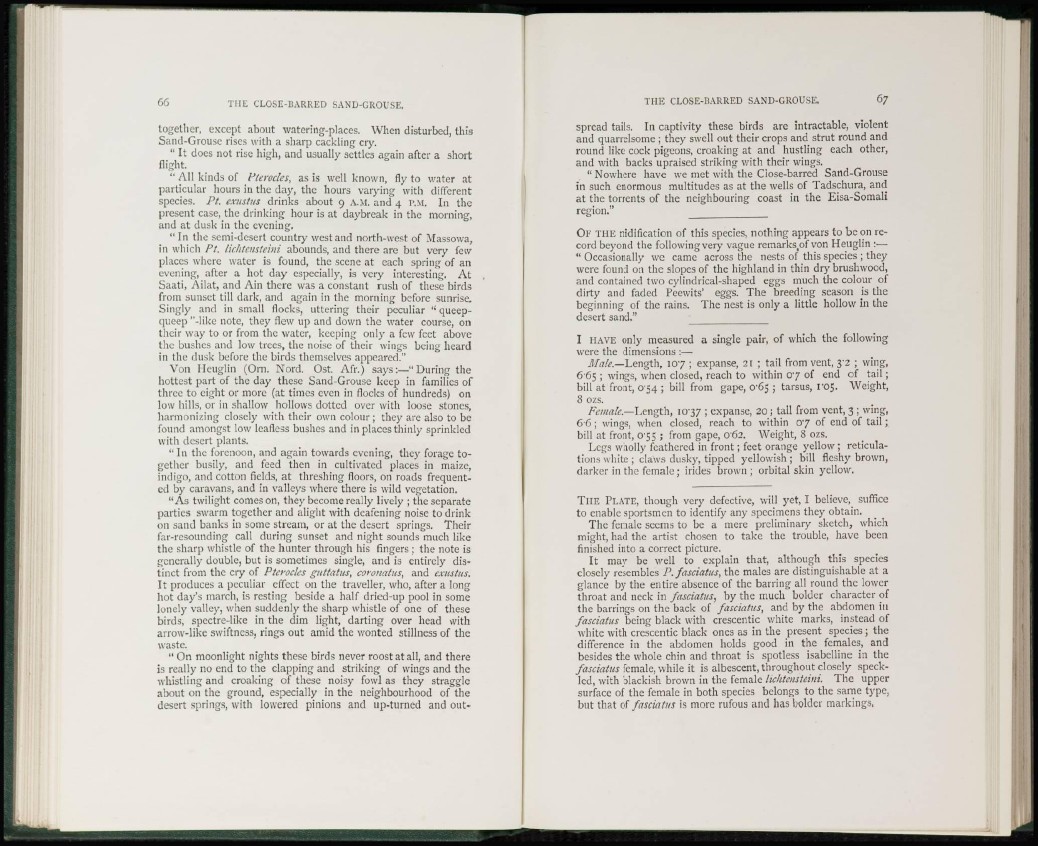
66 THE CLOSE-BARRED SAND-CROUSE,
together, except about watering-places. When disturbed, this
Sand-Grouse rises with a sharp cackling cry.
" It does not rise high, and usually settles again after a short
flight.
" All kinds of Pterocles, as is well known, fly to water at
particular hours in the clay, the hours varying with different
species. Pt. exustus drinks about 9 A.M. and 4 P.M. In the
present case, the drinking hour is at daybreak in the morning,
and at dusk in the evening.
" In the semi-desert country west and north-west of Massowa,
in which Pt. lichtensteini abounds, and there are but very few
places where water is found, the scene at each spring of an
evening, after a hot day especially, is very interesting. At
Saati, Ailat, and Ain there was a constant rush of these birds
from sunset till dark, and again in the morning before sunrise.
Singly and in small flocks, uttering their peculiar " queepqucep
"-like note, they flew up and down the water course, on
their way to or from the water, keeping only a few feet above
the bushes and low trees, the noise of their wings being heard
in the dusk before the birds themselves appeared."
Von Ileuglin (Orn. Nord. Ost. Afr.) says:—"During the
hottest part of the day these Sand-Grouse keep in families of
three to eight or more (at times even in flocks of hundreds) on
low hills, or in shallow hollows dotted over with loose stones,
harmonizing closely with their own colour ; they are also to be
found amongst low leafless bushes and in places thinly sprinkled
with desert plants.
" I n the forenoon, and again towards evening, they forage together
busily, and feed then in cultivated places in maize,
indigo, and cotton fields, at threshing floors, on roads frequented
by caravans, and in valleys where there is wild vegetation.
" A s twilight comes on, they become really lively ; the separate
parties swarm together and alight with deafening noise to drink
on sand banks in some stream, or at the desert springs. Their
far-resounding call during sunset and night sounds much like
the sharp whistle of the hunter through his fingers ; the note is
generally double, but is sometimes single, and is entirely distinct
from the cry of Pterocles guttatus, coronatus, and exustus.
It produces a peculiar effect on the traveller, who, after a long
hot day's march, is resting beside a half dried-up pool in some
lonely valley, when suddenly the sharp whistle of one of these
birds, spectre-like in the dim light, darting over head with
arrow-like swiftness, rings out amid the wonted stillness of the
waste.
"On moonlight nights these birds never roost at all, and there
is really no end to the clapping and striking of wings and the
whistling and croaking of these noisy fowl as they straggle
about on the ground, especially in the neighbourhood of the
desert springs, with lowered pinions and up-turned and out-
THE CLOSE-BARRED SAND-GROUSE. 67
spread tails. In captivity these birds are intractable, violent
and quarrelsome ; they swell out their crops and strut round and
round like cock pigeons, croaking at and hustling each other,
and with backs upraised striking with their wings.
" Nowhere have we met with the Close-barred Sand-Grouse
in such enormous multitudes as at the wells of Tadschura, and
at the torrents of the neighbouring coast in the Eisa-Somali
region."
OF THE nidification of this species, nothing appears to be on record
beyond the following very vague remarks.of von Heuglin :•—•
" Occasionally we came across the nests of this species ; they
were found on the slopes of the highland in thin dry brushwood,
and contained two cylindrical-shaped eggs much the colour of
dirty and faded Peewits' eggs. The breeding season is the
beginning of the rains. The nest is only a little hollow in the
desert sand."
I HAVE only measured a single pair, of which the following
were the dimensions :—
Mole.—Length, 107 ; expanse, 21 ; tail from vent, 3'2 ; wing,
665 ; wings, when closed, reach to within 07 of end of tail;
bill at front, 054 ; bill from gape, 065 ; tarsus, ro5- Weight,
8 ozs.
Female.—Length, 1037 ; expanse, 20; tail from vent, 3 ; wing,
6 6 ; wings, when closed, reach to within 07 of end of tail;
bill at front, C55 ; from gape, 062. Weight, 8 ozs.
Legs wholly feathered in front; feet orange yellow ; reticulations
white ; claws dusky, tipped yellowish ; bill fleshy brown,
darker in the female ; irides brown ; orbital skin yellow.
THE PLATE, though very defective, will yet, I believe, suffice
to enable sportsmen to identify any specimens they obtain.
The female seems to be a mere preliminary sketch, which
might, had the artist chosen to take the trouble, have been
finished into a correct picture.
It may be well to explain that, although this species
closely resembles P. fasciatus, the males are distinguishable at a
glance by the entire absence of the barring all round the lower
throat and neck in fasciatus, by the much bolder character of
the barrings on the back of fasciatus, and by the abdomen in
fasciatus being black with crescentic white marks, instead of
white with crescentic black ones as in the present species; the
difference in the abdomen holds good in the females, and
besides the whole chin and throat is spotless isabelline in the
fasciatus female, while it is albescent, throughout closely speckled,
with blackish brown in the female lichtensteini. The upper
surface of the female in both species belongs to the same type,
but that of fasciatus is more rufous and has bolder markings,